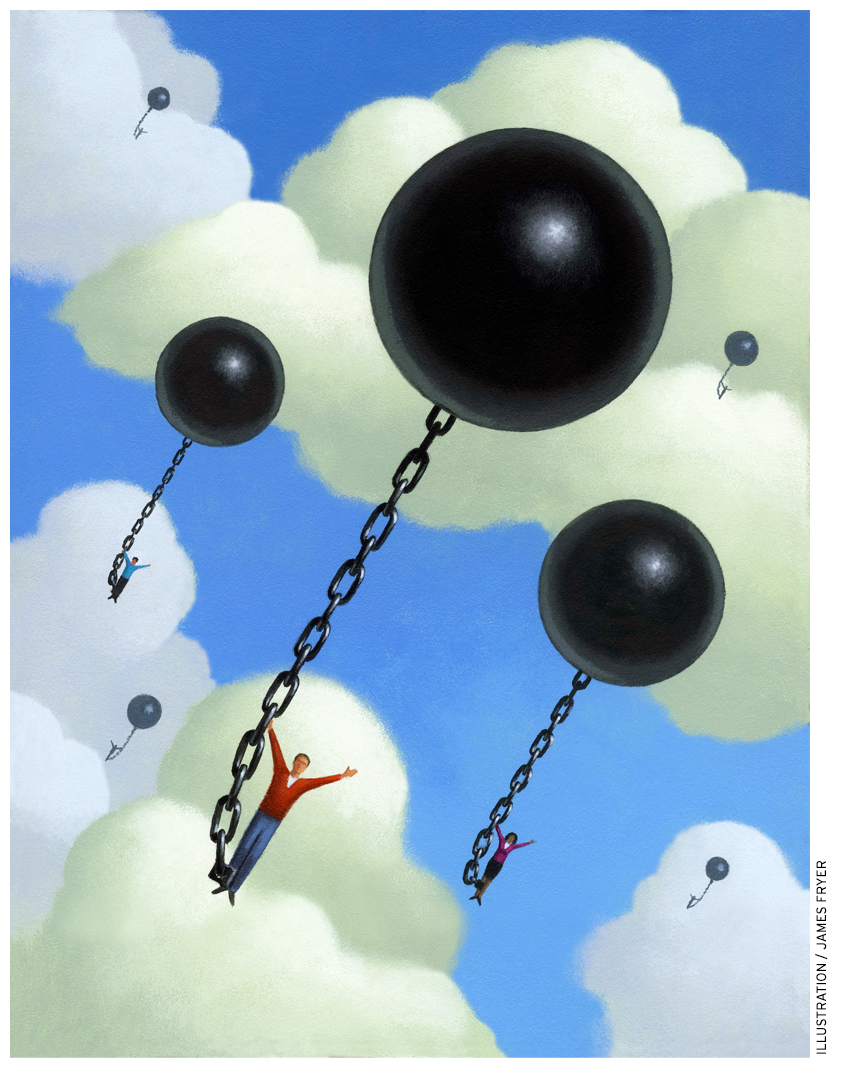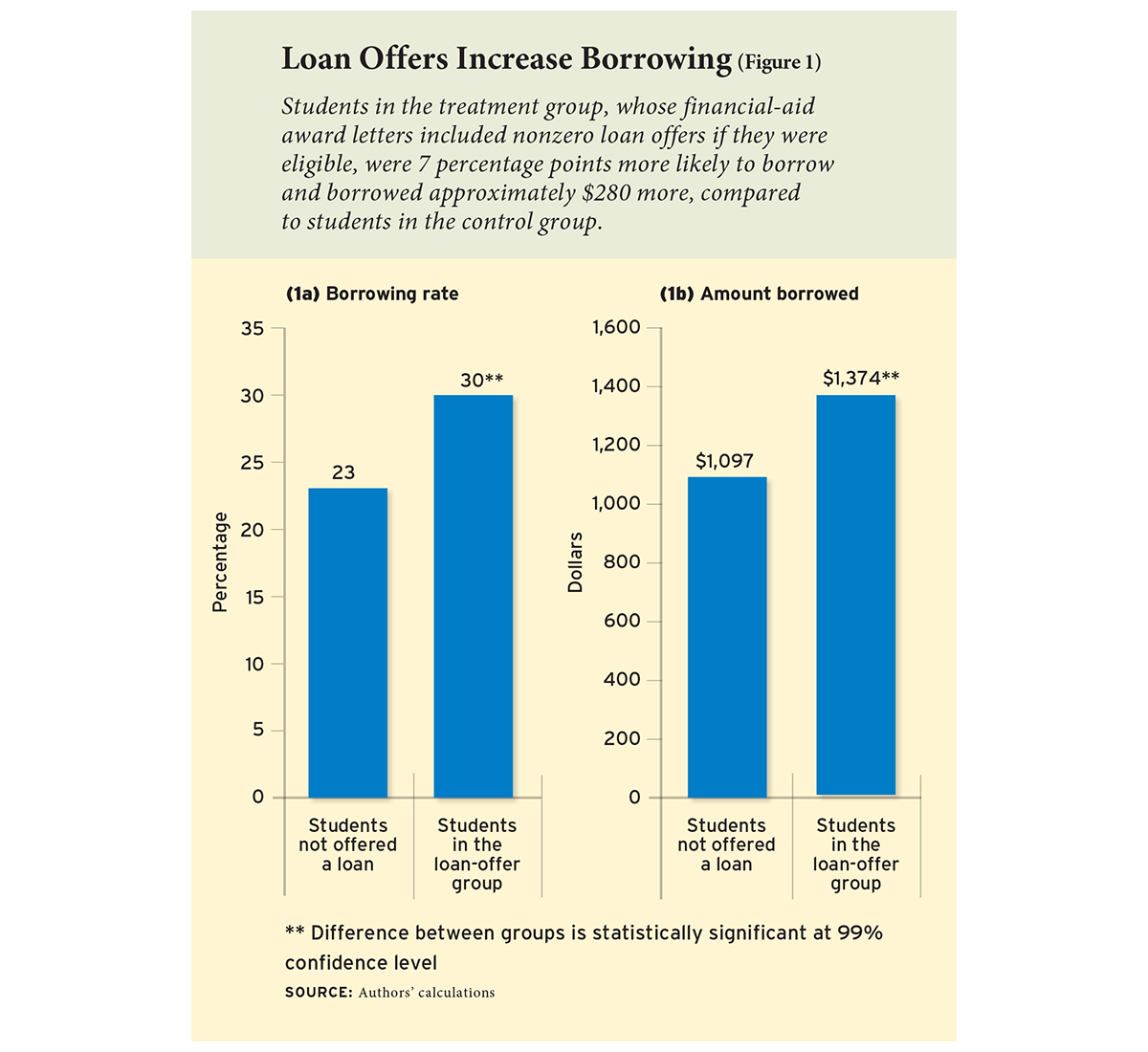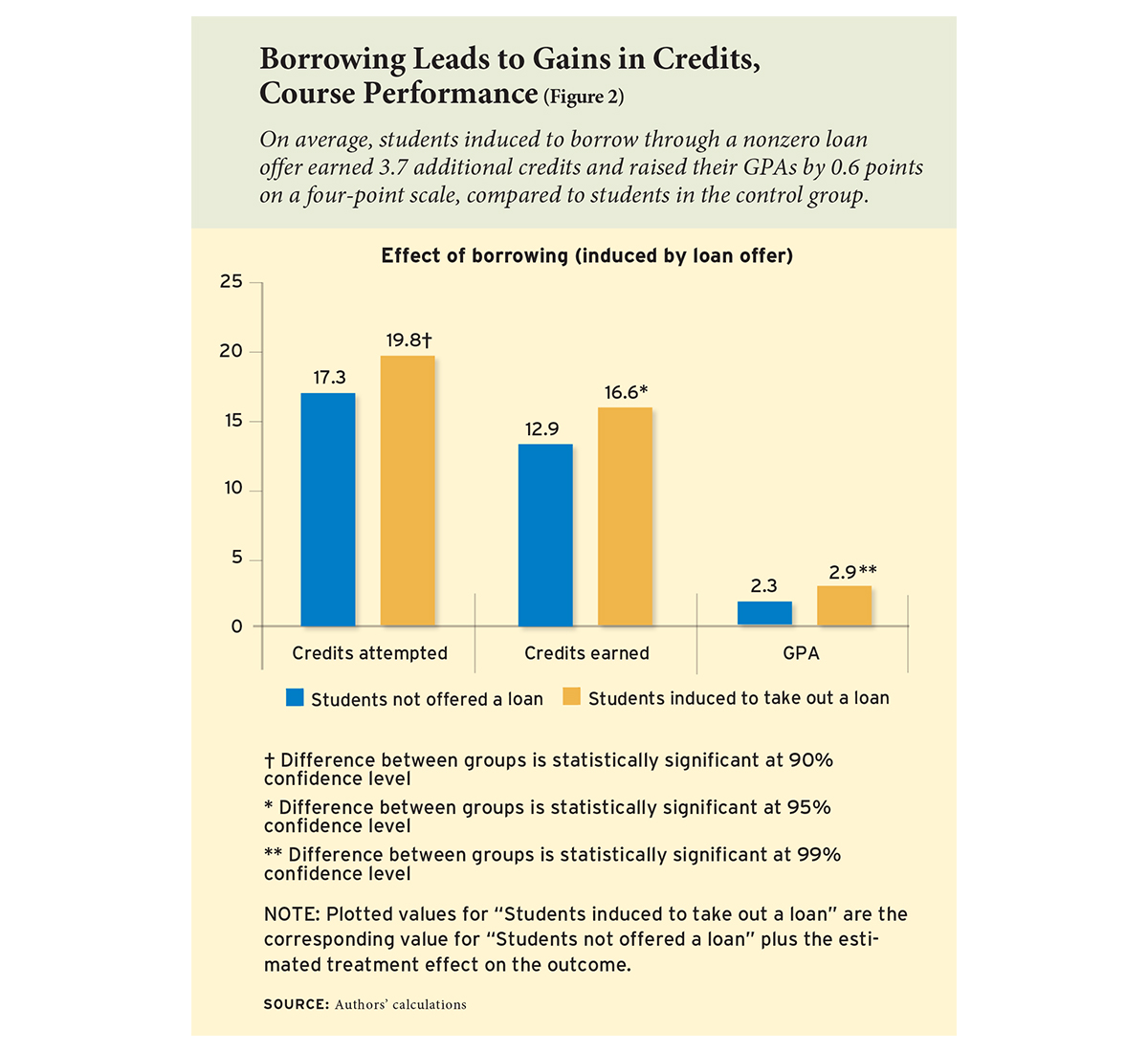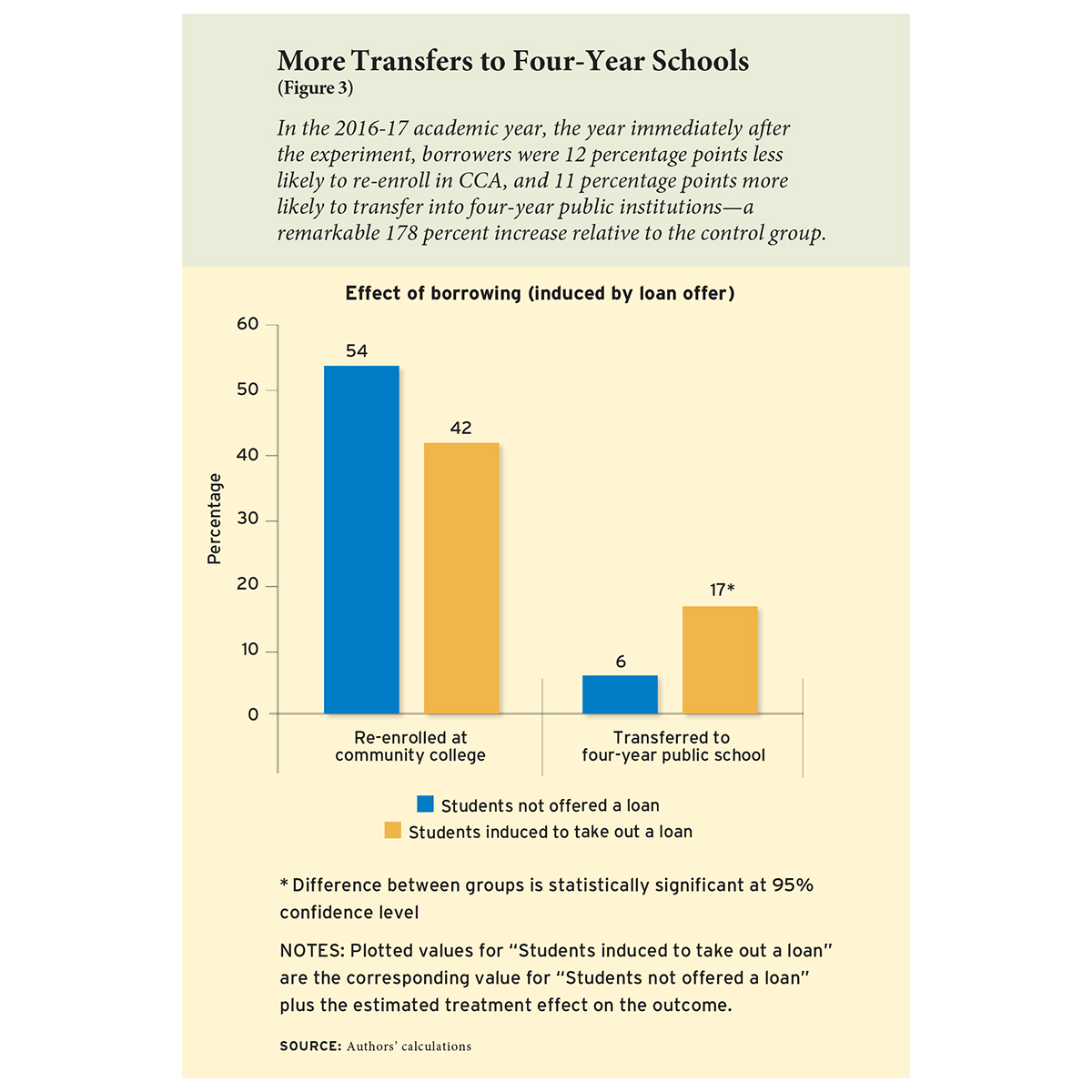 The number of undergraduates in the United States has increased by more than 30 percent since 2000, with two-year institutions absorbing the majority of new students. At the same time, outstanding student-loan debt has grown nationwide, reaching $1.4 trillion in 2018.
The number of undergraduates in the United States has increased by more than 30 percent since 2000, with two-year institutions absorbing the majority of new students. At the same time, outstanding student-loan debt has grown nationwide, reaching $1.4 trillion in 2018.
Many of those students are attending open-access community colleges, where tuition is relatively low, helped by substantial support from federal and state grant aid. Still, the remaining costs associated with college attendance—such as books and supplies and living expenses—may be important determinants of students’ success. For these students, the resources provided by student loans could mean the difference between working longer hours and having additional time to spend in class or on coursework.
Although the federal student-loan program exists to provide such resources, the growth in student loan debt is often described as a “crisis,” and many colleges and universities have implemented policies designed to reduce student borrowing. However, there is little rigorous evidence on the causal effect of loans on educational outcomes. As a result, it is not clear whether efforts to reduce borrowing will benefit or harm students.
We address this question through a randomized experiment at a large community college. Colleges that participate in the federal student-loan program must make loans available to all of their students, and the amount that each student can borrow is determined by his or her class standing and dependence on parental support. However, colleges have discretion over how much loan aid, if any, to list on students’ annual financial-aid award letters. Depending on the school’s approach, a letter might provide a loan “offer” equal to the maximum dollar amount a student could borrow, zero, or anything in between.
We designed our experiment to test whether the decision of the amount of loan aid to list—a choice being made every year by most community colleges—has meaningful effects on borrowing and student attainment. Specifically, our experiment varied whether students were offered a nonzero loan amount in their financial-aid award letters.
Our study provides the first rigorous evidence of the effect of loan offers on both borrowing and academic performance. We find that students whose aid letters offered nonzero loans were more likely to borrow, and those who borrowed did better in school. Students who received nonzero loan offers were 7 percentage points more likely to take out a loan (a 30 percent increase) and borrowed $280 more than students whose letters offered $0 in loans.
Students who borrowed as a result of receiving a nonzero loan offer earned 3.7 additional credits and raised their grade point averages (GPAs) by more than half a grade on a four-point scale, both representing increases of roughly 30 percent. One year after the intervention, borrowers were 11 percentage points more likely to have transferred to a four-year public institution. Based on these results and past research on the earnings gains from college persistence and attainment, we estimate that borrowers are likely to see an increase in their future earnings of at least $370 per year.
Leeway on Loan Offers
Most U.S. college students finance their education with a combination of scholarships, grants, paid employment, and loans. Student loans follow borrowers well into adulthood: some 37 percent of U.S. adults ages 18–29 carry student-loan debt, as do 22 percent of adults ages 30–44. The vast majority of student borrowing takes place through the federal government, which offers relatively low fixed-interest rates, loan-forgiveness options, and more flexible repayment terms than private banks do, in addition to grants and on-campus jobs for low-income students.
Students apply for these programs by filling out the Free Application for Federal Student Aid (FAFSA), which gathers information on family income, assets, and other family members’ college attendance. This information is fed through a complicated formula to calculate an Expected Family Contribution (EFC), which is the federal government’s measure of how much money a student (and her family) is able to pay for school.
All students who have completed a FAFSA, are enrolled at least part-time, and have not defaulted on federal loans in the past can take out an unsubsidized loan, which accrues interest while students are in school. Students whose FAFSA demonstrates financial need are eligible for subsidized loans; under those terms, the government pays the interest on the loan while the student is enrolled. In both cases, loan repayment does not begin until after the student leaves school or drops below half-time status.
Students who complete a FASFA receive annual financial-aid award letters, which are sent directly from colleges. These letters typically include the student’s EFC and the program-specific expected cost of attendance (that is, tuition and fees, books and supplies, and living expenses). In addition, the letter provides an estimate of the student’s net cost of attendance, based on the combination of scholarships, grants, loans, and work-study assistance the college is offering that particular student. Students who enroll in a sufficient number of credits automatically receive any offered grants, but must formally request student loans.
A college student’s class standing, dependency status, and unmet need determine the maximum amounts of subsidized and unsubsidized loans for which she is eligible. However, colleges have discretion to show the student a smaller amount in the financial-aid award letter. That is, a student whose EFC renders her eligible for a $5,500 federal loan may receive a letter that lists $5,500 in loans, some other dollar amount, or $0. Her eligibility does not change with the amount listed, but the information provided to her does.
Community colleges vary widely in whether and how they communicate information on loan eligibility to their potential students. We surveyed community colleges that participated in the federal loan program in 2014 and 2015 and found that more than half either offer all students $0 or do not offer students loans of any amount. Colleges might avoid making nonzero loan offers with the intention of protecting students from taking on too much student-loan debt or in an attempt to shield the college from the consequences that come with poor loan-repayment rates (including possible loss of their students’ eligibility for federal grants and loans). These schools have lower borrowing rates than schools that make nonzero loan offers to their students: on average, only 16 percent of students took out loans, compared to 29 percent at schools that offer loans. Students at both types of schools receive Pell Grants at comparable rates, suggesting that loan offers are not correlated with average student need.
Student loan-offer policies may contribute to the fact that students at community colleges are less likely to take out student loans than students at more selective four-year institutions, despite having greater unmet need. We find that in nationally representative 2012 data, 70 percent of community college students who applied for federal student aid faced a cost of attendance that exceeded their total resources (including grants, loans, work-study, and personal resources). Among four-year public and nonprofit undergraduates, 58 percent and 60 percent had unmet need. This may have important financial consequences; the same data reveal that low-income community college students were 33 percent more likely to use a credit card to pay for school and 7 percent more likely to work if they did not use federal student loans to cover their unmet financial need.
The Experiment
What impact, if any, does a nonzero loan offer have on student borrowing? While offers in financial aid letters do not alter students’ options, they could still affect student decisions. Loan offers could be misperceived as providing complete information about loan availability or they might be perceived as a recommendation and focus students’ attention on the offered amount.
We conducted an experiment during the 2015–16 academic year at a large community college that we call Community College A, or “CCA.” CCA’s average costs are in line with national averages, with in-district tuition and fees for 2014–15 of approximately $3,100 versus $3,249 nationwide. Financial aid is also similar: approximately 45 percent of CCA students received Pell Grant aid, and 25 percent received federal loans in 2013–14, compared to 41 and 19 percent of students, respectively, at the average community college.
Students at CCA have substantially lower completion rates and slightly worse labor-market outcomes than students at the average community college. Only 5 percent of those who started at CCA as full-time associate degree-seeking students completed a credential within three years, compared to 21 percent of beginning full-time community college students nationwide. Median earnings among federal aid recipients who were no longer enrolled 10 years after they started school are similar for CCA and community colleges nationwide, at approximately $28,000 and $30,253, respectively. And although past CCA borrowers have lower student-loan balances when entering repayment of approximately $4,200 versus $6,563 nationwide, they also have slightly less success repaying their loans.
In the experiment, all financial aid-eligible students were randomly separated into treatment and control groups, with each group of approximately 10,000 students receiving a different financial-aid award letter. Students in the loan-offer treatment group who were eligible to borrow received a loan offer of either $3,500 or $4,500 in their award letter. All loan-eligible students assigned to the control group received financial-aid letters that listed $0 loan offers. Letters with $0 loan offers were similar in form to those offered to millions of community college students each year.
Award letters also displayed available grant and work-study aid. Students who were not eligible for loan aid—either due to having reached their lifetime limit of federal loan aid or due to enrolling in too few credits—received letters that did not mention loans, regardless of their assignment to treatment or control groups. Students received award letters after applying for admission and financial aid, and approximately 84 percent received a letter before the start of the fall 2015 semester.
Loan offers did not affect students’ eligibility for federal loans or the requirement that students complete federal requirements to borrow. CCA clearly displayed information on student loan eligibility on its website, and all students who completed a FAFSA received information on their anticipated eligibility for Pell Grants and federal loans from the U.S. Department of Education. Students in both the loan-offer and control groups were also informed of their eligibility and the process for requesting a loan via email from CCA. Both versions of this email included lang- uage that could discourage borrowing, including an “Important Notice” of loan limits in the treatment-group email and encouragement to “borrow wisely” in the control-group email. All borrowers had to complete CCA’s electronic-loan request form and actively select a specific loan amount, and first-time borrowers were also required to complete federal entrance counseling and sign a legal agreement promising to repay the loan.
In loan-offer group letters, offered loan amounts depended on the student’s class standing: treatment-group freshmen received $3,500 loan offers and sophomores received $4,500 offers, the maximum amount that each group could potentially receive as a subsidized loan but less than the overall maximum students were allowed to borrow. Students with sufficient unmet need were offered the full amount as subsidized loans, while those with lower unmet need received a combination of subsidized and unsubsidized loan offers. Based on eligibility, nonzero loans were ultimately offered to 81 percent of the loan-offer group and to no students in the control group.
The Results
Effects on borrowing: Students in the loan-offer group were more likely to borrow compared to students in the control group (see Figure 1a). Some 30 percent of students in the loan-offer group borrowed, compared to 23 percent of students in the control group, a 30 percent difference. Students in the loan-offer group also took on more debt, on average. Loan-offer group members borrowed $1,374, on average, approximately $280 (26 percent) more than the $1,097 mean for control-group members (see Figure 1b).
We also examine the effects of receiving nonzero loan offers across student subgroups, including past experience with borrowing (any outstanding debt versus no outstanding debt), financial resources (Pell Grant-eligible versus ineligible), prior CCA enrollment (new versus returning), class standing (freshman versus sophomore status), and dependency status. Receiving a nonzero loan offer significantly increased the probability of borrowing and the amount borrowed for students in all subgroups.
Effects on attainment: Students in the loan-offer group also did better in school compared to students in the control group. Students in the loan-offer group attempted and earned more credits and had higher GPAs in the year of the experiment.
Simply comparing the outcomes for the loan-offer and control groups likely understates the effects of borrowing, because the experiment included students who were not eligible for loans (so the treatment could not have affected their borrowing), and not all eligible students borrowed. We thus report results that isolate the effect of the additional borrowing by scaling effects on academic outcomes by the effect on the number of students who borrowed.
Students who borrowed because they received a nonzero loan offer signed up for more classes and progressed further in school compared to students in the control group. They attempted 2.5 credits more than students in the control group, on average, and earned 3.7 credits more during the 2015–16 academic year (see Figure 2). They also earned significantly higher GPAs over the academic year, with a cumulative increase of more than half a point on a four-point scale—roughly the difference between a “B” and an “A-” grade. This suggests that borrowing helped students both afford more courses and do better in the courses they took.
In our experiment, borrowing did not have significant effects on the likelihood of earning a degree by the end of the 2015–16 academic year. This finding is not surprising given that most students in our sample were more than one year of full-time attendance away from completing their degree programs. Estimated effects on degree completion were positive but not statistically distinguishable from zero within the period of study.
The average loan-offer group student who borrowed because of the loan amount listed in their award letter took out a $4,000 loan. This suggests that an additional $1,000 in loans leads students to attempt 0.6 more credits, complete 0.9 more credits, and earn a GPA that is 0.16 higher.
We also estimate effects on educational attainment in the 2016–17 academic year, the year immediately after the experiment, based on data from the National Student Clearinghouse. We find that borrowers were 12 percentage points less likely to re-enroll in CCA that year, a decrease of 23 percent, which falls just short of statistical significance (see Figure 3). We find similarly sized positive impacts of borrowing on the probability of transferring into a bachelor’s degree program within a four-year public institution. Given the relatively low rate of transfers from CCA into four-year public institutions, the statistically significant increase of 11 percentage points in the probability of a transfer represents a remarkable 178 percent increase relative to the control group.
It will be several years before a follow-up analysis can be conducted after most students have completed their education. Long-run outcomes of interest would include degrees earned, wages, outstanding student loans and other debt, and student-loan repayment. Because of the amount of time that would need to pass before such an analysis, and the importance of our short-run results for millions of current college students, we conducted a cost-benefit analysis based on the benefits accruing within our sample period.
Weighing Costs and Benefits
To contextualize our findings, we compare the costs and benefits of nonzero loan offers from two perspectives: the lender, which in this case is the government, and the recipient of the loan, which is the student. We compare our estimates to those found in two other randomized controlled trials targeting community college students’ financial status and educational attainment.
At the City University of New York (CUNY), students in the Accelerated Study in Associate Programs (ASAP) were subject to a suite of requirements and received additional supports and financial assistance, costing an estimated $3,900 per student each year. Researchers at MDRC found that ASAP students earned 2.1 more credits per semester and were twice as likely to graduate within three years of program entry, suggesting an annual increase of 1.1 credits earned per $1,000 provided.
A different experiment was conducted at several community colleges nationwide: the Performance-Based Scholarship (PBS) intervention. Students were randomly assigned to be eligible to earn up to $1,500 per semester in incentive payments if they met specific academic goals, with the eligible populations and structure and size of incentives varied across experimental sites. Economists Lisa Barrow and Cecilia Rouse report that, at the most successful PBS site, treatment-group members earned significantly more credits than control-group members, with first-year impacts of approximately 1 additional credit per $1,000 of program expenditures.
Our estimated effect of 0.9 credits earned per $1,000 increase in loans is comparable to the magnitude of estimated effects per $1,000 spent by both the ASAP and PBS programs. It is important to note, however, that we have yet to observe CCA students for the length of time that it took for the ASAP program to produce significant increases in degree completion, which prevents us from comparing effects of borrowing to ASAP program expenditures on degree receipt.
On the other hand, in our setting, the additional $1,000 is loaned directly to the student rather than spent by the college, meaning that the long-run costs may be substantially lower, since loan aid is designed to be repaid. If we assume that 20 percent of the borrowers in our experiment will default on their loans, in line with the average three-year default rate for CCA, the federal government’s expected cost per $4,000 loan is $444. This suggests a cost-benefit ratio of 8.1 additional credits per $1,000.
Lending may be wise for the government. But does it benefit students in the longer run? We draw on existing research to determine the earnings effect on borrowers, and estimate they will earn $370 more per year, on average, based on taking out a $4,000 student loan. Assuming real earnings effects are constant over time, we conclude that the kind of additional borrowing induced by the loan offer letters is likely beneficial to most students.
Implications
Our study provides the first evidence of the causal effects of loans on student outcomes. Student debt, widely considered a burden, may help facilitate success for students, especially those who lack other resources that could be used to cover costs associated with college attendance.
We estimate that loan offers increase community college students’ educational attainment by substantially more per expected dollar of government spending than other interventions that have been evaluated with experiments. We cannot conclude that offering a loan will enhance the well-being of every student, but we project that the average borrower would benefit financially from taking on debt that is used to pay for necessary college costs. Borrowers earn more credits and get better grades, which can provide real, lasting economic benefits.
Our results suggest that offering loans can help more students succeed in school. Yet more than five million students attend U.S. colleges that do not offer loans in financial-aid award letters, and nearly one million more attend colleges that do not participate in the federal loan program. However well intended, efforts to discourage student borrowing may be hindering students’ progress rather than protecting their future. Policymakers, college leaders, and students weighing the risks of student-loan debt should keep this fuller picture in mind.
Benjamin M. Marx is assistant professor of economics at the University of Illinois at Urbana-Champaign. Lesley J. Turner is assistant professor of economics at the University of Maryland.
This article appeared in the Winter 2019 issue of Education Next. Suggested citation format:
Marx, B.M., and Turner, L.J. (2019). The Benefits of Borrowing: Evidence on Student Loan Debt and Community College Attainment. Education Next, 19(1), 70-76.





